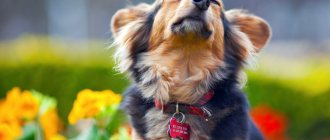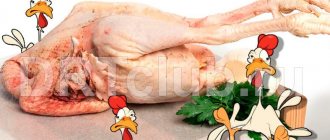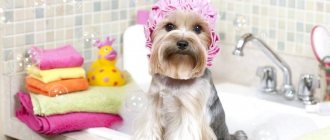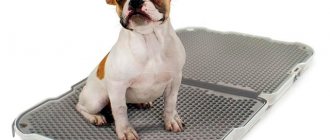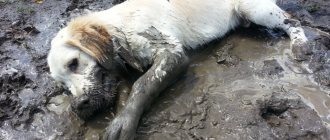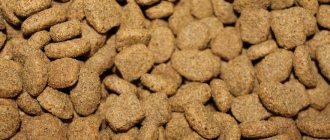Veterinarian tips for caring for dogs: keeping your pet indoors
Veterinarian tips for caring for dogs:
- When you get a dog, you must first determine where it will live, in the house or in the yard? It is necessary to arrange a good place for the dog in the house, taking into account its size. You need to choose a place where your animal can rest and watch what is happening around.
- Basically, such a place is chosen in the hallway so that the dog can perform a protective function - to protect a person’s house. There is no need to choose a place for it in the kitchen or in someone's bedroom; soon the dog will begin to climb on the table and move onto your bed or your child's bed.
- You should also not place your dog near heating appliances, as this will negatively affect the animal’s fur and body temperature. Once you have chosen the ideal place to place your dog, you need to arrange it.
- For large dogs, a mattress is laid out, and if the dog is miniature, then it is equipped with a basket or a lounger. If the dog is a dwarf breed and you do not walk it outside, then you need to organize a place for the toilet.
- You need to put a special plastic tray and fill it with filler designed to absorb odor. All this is sold in pet stores. A dog that lives in a house also needs a place where it will eat.
- It should be in the kitchen and not have any obstacles so that the dog can freely go and eat. You need to put two deep bowls, made of high-quality material, preferably metal. They wash well and do not absorb the smell of food. One bowl for food, the other bowl for water.
A responsible owner means a healthy dog.
Instructions for Beginners
Beginning owners of furry happiness should take care of preparing their home for receiving a dog in advance. Even before the puppy arrives, it is important to acquire:
- bed;
- bowls for feeding and drinking, as well as one bowl for long walks and hikes;
- means of personal hyena;
- leash, harness and collar;
- a basic first aid kit (the veterinarian will help you assemble it);
- toys.
You should choose a secluded place for the dog in the apartment.
But it should not be located in an empty room so that the puppy does not become lonely. It is optimal to get a soft kennel - the puppy will be comfortable there. Toys should be placed close to the bed, in free access. In the absence of the owner, dogs not only sleep, but also try to have fun. If the puppy cannot get to his favorite ball, he will chew on something more accessible. It is important to know! After the puppy arrives in the apartment, you should remove all objects that it can chew.
After the dog is brought into the apartment, it is important to give him time to get comfortable. No need to carry it from room to room. This is now his territory and soon he will definitely explore every corner of it. The baby must know where his place is, where he can eat and relieve himself. If the puppy is very small, all this should be in almost one place at first.
Setting up a place for a puppy
Veterinarian tips for caring for dogs: keeping your pet outdoors
Veterinarian tips for caring for dogs:
- If the dog will live in the yard, then you need to create all the necessary conditions for it. First you need to determine what material the booth will be built from, where to install it and what size it should be.
- Basically, wood is chosen for the construction of a booth; it is the most heat-insulating material. You need to take good care of the booth, treat the cracks in it so that various parasites, such as fleas or ticks, do not appear there.
- You need to build a booth in accordance with the size of the dog, so he can warm it with his breath during the cold season. The booth is usually installed in a quiet place under a tree with dense foliage, so that in hot weather it shelters the dog from the scorching sun, and in winter from the cold wind. The entrance is made from the windless side.
- By winter, a caring owner should insulate the booth for his pet. They mainly insulate with polystyrene foam and cover it with a sheet of plywood so that the dog does not chew the foam. Veterinarians advise not to place the kennel directly on the ground, but to place it on bricks and lay straw there for the winter, so the floor in the kennel will not freeze.
- If you do everything correctly, then even in severe frost there will be a positive temperature in your dog’s kennel. If you don't want your dog to live on a leash, you can fence off an area for him.
Nutrition
The diet of an older dog should be special. It is ideal if a veterinarian picks him up, but the owner himself can do this.
What should be in the diet:
- vegetable fiber – for normal functioning of the gastrointestinal tract;
- vegetable fats - we replace animal fats with them;
- foods rich in vitamins and minerals.
Older dogs are limited to fish and meat so as not to overload the kidneys with food rich in protein. A third or fourth of the total amount of meat eaten should be replaced with porridge and vegetables. Food is salted to a minimum to avoid swelling. Let your pet regularly eat cottage cheese to strengthen its bones and drink kefir. Make sure your dog drinks enough water and cook vegetable soups.
The following are prohibited:
- bones;
- fat meat;
- smoked meats and sausages;
- food from your table.
Owners of older dogs who eat ready-made food should choose canned food that is labeled accordingly. The composition should not contain flavorings, preservatives and other harmful substances, the negative effects of which only a young body can cope with.
Feed your dog small portions, but more often - this will make it easier on the digestive system. Older dogs are prone to obesity due to less activity. And if you cannot feel your pet’s ribs, then this is a signal to feed less. And so that the animal does not suffer from a reduced diet, give it vitamin supplements recommended by the veterinarian.
If it is already difficult for your dog to eat solid food, then grind it into minced meat or simply bring it to a soft consistency; meat and vegetables can be given in small pieces. Make sure food is warmed to room temperature.
Veterinarian tips for caring for dogs: feeding your pet
Veterinarian tips for caring for dogs:
- You need to feed your dog 2 times a day.
- Veterinarians advise feeding dogs proper and natural nutrition.
- There is no need to feed your dog what you eat yourself: salty, fried, sweet, fatty, sausage, cheese, pork.
- Your pet's diet should consist of lean meat, vegetables, dairy products and cereals.
- Veterinarians advise not to feed dogs flour, as this disrupts the animal’s intestinal microflora.
- Beef is the most favorite and healthy meat for four-legged friends, as well as horse meat and rabbit meat.
- Chicken and turkey meat should be given with caution, while monitoring the reaction on the skin.
- The meat must be given raw at least every other day, after scalding it with boiling water. With raw meat, the dog, as a carnivorous animal, receives the necessary phytonutrients necessary for the normal metabolic processes of its body. Without raw meat, your dog will likely become sick and may experience hair loss.
- You can also feed your dog dry food, which is now sold in any store.
- You need to buy not the cheapest one, as it has a bad effect on the dog’s health, but a premium one. You can’t mix dry food and regular food; it’s better to feed them separately, either one or the other.
- Don't overfeed your dog. A fat dog is a sick dog. Ask your veterinarian about food intake for your breed of dog.
- Fermented milk products need to be chosen at such a fat content that the dog does not have a weakened stomach. Veterinarians advise using such products in food with no more fat than 9%.
- You can eat almost anything from vegetables except cucumbers and cabbage. It is better to give vegetables either with meat or separately from everything else, but in no case with fermented milk products. Before feeding your pet vegetables, you need to chop them. Greens are also good for animals.
- A dog needs vegetables, both boiled and raw. If your dog doesn't eat raw grated vegetables, mix them a little into his favorite food.
- You can add chicken and quail eggs to dairy foods, but no more than three times a week. If the dog is healthy and feels good, then it does not need vitamins. Veterinarians recommend vitamins for puppies and pregnant dogs.
Dog walking rules and physical activity
The rules for keeping dogs of any breed are regular walks. It is necessary to take the dog outside at least 2 times a day, in the morning and evening hours.
For small dogs, 5-10 minute walks will be enough to feel comfortable.
Representatives of larger breeds will require longer stays outside and greater physical activity.
The average duration of walks should be about 2 hours a day.
It is advisable to equip a play area in the house for your pet and devote some time every day to communicate with him and have fun together.
Physical activity is very important for a dog’s health, strengthening its immunity, cardiovascular system, and increasing vitality.
Veterinarian Tips for Caring for Dogs: Pet Accessories
Veterinarian tips for caring for dogs:
- Veterinarians advise owners of four-legged friends to buy a collar, muzzle, toys, leashes, comb or brush. These are the most necessary accessories for pets.
- The collar is put on the dog in the neck area and a leash is attached to it. The collar is fastened according to the size of the dog’s neck; it should not be too tight or too loose. An address tag is also attached to the collar; this is a pendant with the coordinates of the animal’s owner, so that in case of loss, it can be returned to its owners.
- A muzzle provides protection to people from dog bites. It is also designed to protect your pet from junk food that he might pick up on the street.
- Leashes can now be purchased from various materials and different lengths. They are necessary for walking dogs on the street. Roulette leashes have become popular now; they are adjustable in length.
- Toys are also made from various materials, the safest material is latex; if a dog swallows it, it will simply be digested.
- Combs and brushes are essential for grooming dogs' fur. We'll talk about this below.
Accessories are an integral part of animal care.
Walking with your pet dog, precautions
Walking is a time for fun. Dogs love to frolic with their owners and other animals. It will be great if your pet finds friends and neighbors in the park or yard and sees them every day. Dogs also know how to make friends.
On walks, a domestic dog may meet a mongrel who will “give” him fleas. Ticks lie in wait for the dog in the grass, and parasites in the branches and foliage. To protect your pet, just put a flea and tick collar on it. After walks, you should inspect your dog for pests. Carry out deworming every six months.
A dog in an apartment will not cause much trouble if you approach this issue with full responsibility. The more and better you take care of your pet, the more love it will show towards its owner.
Veterinarian tips for caring for dogs: washing your pet
Experts advise taking the first bath seriously, because further bathing will depend on how it goes. If the first bath goes well, then the dog will be delighted in the future, but if the first bath goes wrong, the dog will resist.
Veterinarian tips for caring for dogs:
- Praise your pet to make him feel positive.
- It is better not to comb dirty fur, as you can damage the hair structure.
- There is no need to bathe your dog very often; it is better to do it as soon as it gets dirty. Of course, this procedure is done more often in the summer, because the dog quickly gets dirty, and less often in the winter. It is better to wash your paws every time after a walk. Veterinarians recommend washing your dog 1-2 times a month and only with a special shampoo, since the pH of dogs’ skin is different from the pH of human skin.
- They bathe dogs in the bathtub, but there is no need to take a full bath; only the animal’s paws should be in the water.
- Make sure that water does not get into the animal's ears. To be on the safe side, it is better to plug your ears with cotton wool.
- Bath procedures are best carried out in the evening or during the day, then it is not recommended to go outside for 4 hours after bathing, so that the dog does not get sick.
- After bathing, veterinarians advise applying a special product to the dog’s fur to prevent tangles. If they cannot be avoided and they cannot be combed out, then they need to be cut off with scissors.
- After bathing, let your dog shake his coat to get rid of excess water, then gently pat it down with a towel. Do not make sudden movements, as you may harm the animal.
- You should only wash your pet with dog shampoos. They can be diluted if the dog is not very dirty, this way you can use it sparingly, it will not lose its properties. Many owners buy bath products with lanolin, this is a special oil that is added to shampoo to protect and shine the coat.
Praise your dog more often to evoke positive emotions in him.
Hygiene rules, how to bathe correctly
Daily hygiene for dogs includes brushing their teeth, washing their paws and belly after walks, and combing their fur. Every week the dog's ears are cleaned and its eyes examined. Every three weeks, your pet should have its nails trimmed and a hygienic trim done, cutting off the area around the tail, muzzle and between the pads on its paws.
Decorative breeds are bathed every 7-10 days. Appropriate hair care products should be selected. On sale now you can find shampoos, conditioners, masks individually for each breed.
When bathing, it is important not to pour water into your dog's ears and nose. The water should be comfortably warm. If you teach a puppy to bathe, in the future your pet will endure this procedure with pleasure.
It is important to know! After bathing, it is important to protect the four-legged animal from hypothermia and drafts.
Bathing the dog
Veterinarian Tips for Grooming Dogs: Grooming
Start brushing your pet from an early age, so he will quickly get used to this daily procedure. A dog's coat not only protects it during the cold season, but it can also be used to monitor your pet's health. An experienced veterinarian can determine the animal’s age, various diseases, and the environment in which the pet lives by the condition of its coat. In order for the dog to be not only beautiful, but also healthy, a loving owner takes very careful care of the fur of his four-legged friend.
Veterinarian tips for caring for dogs:
- Nutrition. What kind of fur an animal has directly depends on its nutrition. To keep the coat healthy, the food must be of good quality. With the food she eats, she should receive all the necessary minerals and vitamins.
- Health . If a dog has any health problems, this will immediately affect the condition of its coat. A healthy dog's coat is shiny and odorless, but a dog that has health problems has hair that begins to fall out, dandruff appears, and becomes dull.
To comb, you need to purchase quality tools. For dogs with short hair, only a comb is suitable, but for a long-haired pet you need more tools: a comb with long teeth, a tangle cutter, a slicker brush. It is recommended to start combing long hair from the ends, so you will not damage it.
A well-groomed coat is the beauty and health of an animal.
Which dog is considered old?
A dog's lifespan is short, and the rate of onset of old age depends on the dog's breed. When a large breed pet turns seven years old, he has already reached a respectable age. For dogs of small breeds, old age begins later - after reaching eleven years of age, and their life expectancy is longer.
An attentive owner recognizes the signs of aging:
- teeth wear out;
- vision decreases;
- the hairs on the head turn gray;
- appetite changes;
- problems with bowel movements and urination appear;
- temperament changes - activity decreases.
Veterinarian advice on caring for dogs: diseases, their symptoms
A dog is susceptible to various diseases, and it doesn’t matter if it’s a domestic dog or a mongrel. If an animal gets sick, there is a high risk for humans to become infected from it. Let's look at the diseases that dogs can get.
Viral diseases. These include: herpes, rabies, otitis media, pneumonia. Symptoms that can be used to determine that a dog has a viral disease are as follows:
- runny nose;
- loss of appetite;
- sneezing;
- hard breath;
- lethargy;
- elevated temperature.
Skin diseases. These include dermatitis, scabies and lichen. The symptoms of such diseases are as follows:
- redness on the skin:
- itching;
- hair loss.
Oncological diseases. This disease affects not only people, but also animals. Symptoms of this disease include:
- loss of appetite;
- the animal has suddenly lost weight;
- poor coat condition;
- dull, painful look;
- severe weakness;
- With kidney cancer, blood is found in the urine.
Ear diseases. They can be allergic, viral, bacterial, caused by injuries, and can also occur if the dog has parasites. Symptoms:
- plaque of unnatural color;
- itching;
- redness and swelling of the ears;
- squealing when the ear is touched.
Eye diseases can be infectious, non-infectious, senile, or congenital. Common signs of the disease include:
- itching;
- redness;
- purulent discharge;
- swelling of the eyes;
- cataract;
- profuse lacrimation.
Worms. This disease includes opisthorchiasis, taeniasis and others. The symptoms of these invasions are as follows:
- lethargy:
- weight loss;
- bloating;
- intestinal disorders;
- deterioration of coat condition;
- changes in appetite.
A properly raised dog lives a long time - this must be remembered.
If you notice that your dog feels unwell, behaves strangely and begins to look worse, do not self-medicate, contact your veterinarian immediately. He analyzes the dog’s condition, prescribes the correct treatment, and makes a diagnosis. If you wait too long, you can harm your health, and the dog can end in death.
Dog health - general recommendations
To maintain the health of your pet, prevent and timely detect various diseases, you must follow the following recommendations:
- Carry out regular preventive veterinary examinations and seek advice from a specialist if any alarming symptoms appear, changes in the dog’s behavior or appearance (lack of appetite, sleep disturbances, lethargy, apathy, hair loss, discharge from the eyes, ears, nasal passages, etc.). d.).
- Consult a specialist on how to protect your pet from ticks and fleas.
- Carry out regular vaccinations. Vaccinations help prevent infection with infectious diseases, some of which pose a direct threat not only to the health, but also to the life of the pet. Some vaccines are mandatory, while some vaccinations are carried out on the recommendation of a veterinarian. The first vaccinations should be given to the puppy between 6 and 8 weeks of age from birth.
- Conduct antiparasitic programs aimed at protecting the animal from helminth infection. Small puppies require prevention of parasitic diseases monthly. For adult pets, it will be enough to carry out the treatment once every six months. A qualified veterinarian will help you create a correct, individual deworming schedule.
Following these simple rules will protect your pet from a number of dangerous diseases and maintain his health for many years, especially in combination with a balanced diet and proper hygienic care.
What kind of dog suits you?
When you are faced with a choice of what breed of puppy to buy, it is very important not to make a mistake in making a decision. What kind of dog do you dream of? The Shepherd (East European, German, Caucasian, Central Asian), black terrier, Moscow watchdog, St. Bernard, Commander and many other huge shaggy dogs are, of course, very beautiful, strong and capable of faithfully serving and protecting their owners, but they are absolutely not suitable for contents in the apartment. They live best on the street, in the courtyard of a private house or cottage.
Well, what about people living in ordinary apartments? There are other dog breeds for them. Decorative dogs are mainly suitable for apartments: pugs, poodles, Italian Greyhounds, Yorkshire terriers, Chihuahuas, cocker spaniels, as well as many companion dogs, for example, Labradors or Dalmatians. In the apartment you can keep dogs belonging to service breeds: boxers, Dobermans, Rottweilers. They have short hair, and life on the street in the cold season is quite problematic for such dogs.
Another serious question when choosing a four-legged pet is whether you can cope with a strong animal? Many have learned from their own bitter experience that love and affectionate attitude towards a four-legged friend alone is not enough for a large, physically strong dog to begin to unquestioningly obey all the commands of the owner. Remember, if you are not able to gain real authority from the dog, then you will not be able to control his behavior with a one hundred percent guarantee. And this can lead to a variety of troubles - from the inability to trim his claws or remove a bone picked up by an animal on the street from his mouth, to passers-by being bitten on the street. A big dog means a big responsibility!
Sometimes people search the Internet for a “Which dog is right for me” test and completely rely on its results. It is unlikely that one should blindly trust such tests; they can rather be considered an auxiliary tool, or even games or jokes. Often people answer test questions incorrectly and therefore may receive answers that are completely untrue. If you find it difficult to make your own decision, it is best to contact a professional dog handler, who will really be able to give practical recommendations and conduct his own test. “Which dog is right for me?” is a question that should be asked to a specialist, not the Internet.
Situations
Depending on the situation, you will have to contact different authorities. It all depends on what the dog owner does not comply with and what consequences these violations led to.
What to do if you are bitten by someone else's dog
If a dog attack occurs resulting in bites, the victim must:
- Seek medical help and obtain all the necessary documents from the medical institution.
- Contact the police department at your place of residence.
- To write an application.
- Collect all the necessary documents and attach them to the paper.
- Contact the magistrates' court if the amount of damage falls within the limits of 50,000 rubles. And to the district court if the amount is more than specified.
What to do if your dog damages property
In this case, the sequence of actions is as follows:
- Record the damage caused. It is advisable to involve witnesses.
- Write a statement to the police.
- Go to court for compensation.
But, as a rule, it is worth first trying to resolve the conflict situation voluntarily with the owner of the animal. A fine is imposed on the dog owner only from the moment it reaches 5,000 rubles.
What does it mean if there is a “no dog walking” sign?
Such a sign
must be installed in places where walking dogs in any form is strictly prohibited. This allows pet owners to navigate and not break any part of the law. But if a violation occurs, this only increases the level of responsibility.
Is it possible to carry a dog in transport - train, plane, public transport?
Animals can be transported in any type of transport, but certain conditions must be met:
- On trains, dogs are kept in compartments, and the owner of the animal must buy all available seats. It is prohibited to transport animals in carriages with seats. Only one animal per owner can be transported.
- You can carry your dog on the plane in a special carrier, and large breeds with a special restraint.
Ammunition and what you need to take with you
If you got your first dog, you need to think in advance about purchasing a collar, leash and other accessories that you need for a walk.
Ammunition and what you need to take with you:
- Collar – wide collars made of nylon or leather are suitable for puppies. For adult dogs with thin necks, only wide collars are suitable.
- Parforce collar – needed only for training, used as a temporary measure, constant wearing is not recommended.
- A choke collar, a half-bridle, a snatch chain are special accessories that are used as needed.
- Leash - can be a fixed length, shock-absorbing or tape measure. Leashes of a fixed length are suitable for teaching a puppy to walk. Spring leashes that stretch are ideal for teenagers. Tape measures are used for adult, trained dogs.
- A muzzle is an unloved accessory for many dog owners and their charges. The dog should not wear a muzzle all the time, as this significantly reduces the quality of the walk. The exception is potentially aggressive individuals that can harm others. By law, a dog can be walked without a muzzle only in specially designated areas. Whether you put a muzzle on your dog or not, it doesn’t matter - the dog must be accustomed to wearing the accessory in case of transportation, a conflict situation, or the need for the dog’s presence in crowded places.
- A water bottle, bowl or portable drinking bowl is an essential accessory for summer walks.
- A ball, puller or other toy can be used as an irritant for learning and a leisure item if a walk in the company is not a success.
Nail trimming
Many owners openly neglect this procedure, since it is quite complex, time-consuming and is very disliked by most dogs. However, there are still reasons to include it in the category of mandatory ones.
And the point here is not only that excessively long nails pose a significant threat to your floor coverings, carpets and bedspreads, which dogs, following their instinct, intensively “dug out” before lying down.
The point is that an overgrown manicure disrupts the correct placement of the dog’s paw. When walking, she does not rest on her entire foot, as it should be - her toes fan out to the sides instead of being “in a ball.” This forced gait increases the load on the joints, which have a very limited margin of safety, especially in large breeds.
Of course, during walks, the claws wear out naturally, but only if the dog runs on the asphalt for hours, and not stomps on the lawn for 20 minutes. In winter, even hour-long walks do not help solve the problem. Therefore, be that as it may, it is necessary to trim your nails regularly.
How to trim a dog's nails
For this procedure, it is best to use a special nail clipper that has a limiter, by installing which you can adjust the length of the cut part of the claw. This is very important because inside each of them there is a blood vessel, if damaged, blood will flow, the dog will experience discomfort and will lose all confidence in this procedure.
It’s good if your pet has transparent claws, then you can easily see the border where the blood vessel ends. If the claws are black, then you will have to be very careful and shorten them gradually, no more than 1-2 millimeters at a time, because as the claw lengthens, the blood vessel also lengthens.
If you are afraid of damaging your claw, then the best solution would be to go to a veterinary clinic. When trimming nails, you should not forget about the so-called vestigial fifth toe, located on the side of the forelimbs of all dogs.
It is a claw, which, unlike the others, never wears out at all, and therefore can even grow into the skin.
Examples from life
Residents of large and small cities quite often face an unpleasant situation when they are forced to literally “share” a single recreation area with dogs. Moreover, these animals are not homeless, but are walked by their owners in local areas, playgrounds, parks and squares.
This is where negative situations arise that can not only lead to conflict between “dog walkers” and other vacationers, but also, in the worst case scenario, cause damage to health. Most often people encounter the following problems:
- Walking large and medium-sized dogs, as well as fighting breeds, without a muzzle or leash.
- Having dogs in close proximity to or directly on the playground.
- Contamination of public areas with animal excrement that is not removed by their owners, as happens in many countries where laws on keeping pets are fully operational.
- Damage to property by animals. But it should be taken into account that not every damage to the property of third parties will be considered by law as a situation for compensation by the owner of the animal.
- Sometimes there are situations when owners leave their pets in public corridors.
- And finally, the most negative thing is harm to health as a result of an animal attack.
Based on the presented list of possible situations, every citizen, regardless of whether he is the owner of a pet or the person who could potentially suffer from it, should know the set of laws and regulations. After all, they are the ones who regulate the residence of pets in the same territory as humans, that is, in the urban environment and in other settlements, including farms, villages and small towns.
Liability and fines
Owners need to be clearly aware that
they may be fined violating the rules
for keeping pets Its amount depends on what kind of offense occurred and how serious the consequences are.
For example, the fine
for walking dogs in the wrong place
in Moscow ranges from 1,500 rubles, while in St. Petersburg the mayor’s office considered the necessary amount to be up to a maximum of 5,000 rubles.
In a situation where a dog causes damage to a person’s property, a fine and compensation are also due. But liability for the owner occurs only if the damage was caused in the amount of at least 500 rubles.
It is necessary to understand that if the dog’s actions did not lead to negative consequences for human health, then the fines and liability of the owners are regulated by the Code of Administrative Offenses
. If harm was caused to health, then the Criminal Code of the Russian Federation comes into force.
List of violations
When considering situations in which fines may be imposed on an animal owner, it is worth highlighting the following points:
- Fine for failure to remove from a dog
from public areas.
It can be imposed on almost any territory that is under the control of public utilities. For example, a fine for dog excrement
will have to be paid if, while walking the animal, the owner is caught in violation and it is recorded that it was his animal that caused the contamination of the area. The amount is collected in favor of the state, or rather a specific municipality. - You will also have to pay for damaging someone else's property. Here the amounts will be recovered both in favor of the victim and in favor of the state.
- A fine may also be imposed if the dog has had an insignificant negative impact on human health.
Fines and criminal liability
What will happen to the violator? What is the fine for walking a pet in the wrong place?
Administrative
liability arises for minor offenses.
For example, such as a fine for walking
in the wrong place or leaving excrement behind a dog.
But if the dog caused harm to health, which is assessed as moderate or severe, then the owner will already be held accountable under the criminal code and bear criminal liability. In some cases, getting away with a fine will no longer be possible. The owner faces a real criminal sentence if a dog kills a person due to insufficient control or connivance on the part of the pet owner.
Who controls
As for the regulatory authorities that can create the responsibility of the owner, such powers are available to:
- State inspectors of Rosselkhoznadzor.
- Public inspectors.
But, since reality in the vast majority of cases diverges from reality, residents of the houses themselves have to fight for the cleanliness of public areas and compliance with all norms and rules. They can record the situation, shoot a video and send a complaint to the authorities, which have the ability to punish the unscrupulous pet owner.
The simplest and most effective method of dealing with unscrupulous dog owners is a situation in which an active person takes on the responsibility of becoming a public inspector. In this case, he receives certain powers and the ability to influence the situation. To implement this, you need to submit a corresponding application to Rospotrebnadzor.
Training and behavior correction
There are dog breeds that definitely need to be trained. These include shepherds, rottweilers, boxers, dobermans and many others. Your four-legged friend must be able to carry out the owner’s commands; without this, he can be dangerous both for the people around him and for your family members, including children. Almost every city has training clubs where you can sign up for group or individual lessons with dog handlers.
Many people believe that small decorative dogs do not need training, but this is not entirely true. Even such small animals kept in a city apartment can cause disturbance to neighbors, and even to the owners themselves. For example, a dog may be alone at home and bark desperately all day. This behavior requires correction and consultation with a dog handler.
Preventive vaccinations
To protect your four-legged friend from such dangerous diseases as canine distemper, leptospirosis, hepatitis, parvovirosis, piroplasmosis and rabies, it is necessary to receive preventive vaccinations annually. Complex vaccines have proven themselves well: Nobivak (produced in the Netherlands), Eurikan (France). The veterinary clinic will tell you which drug to choose. Before vaccination, an experienced veterinarian should check whether the animal is healthy and whether it can receive this or that vaccination.
The first vaccination is carried out when the puppy is 4-6 weeks old. But the further vaccination schedule should be prescribed by a specialist. A special topic is how to care for your dog before and after vaccination. Approximately 10 days before vaccination, veterinarians advise be sure to treat the animal for worms. For this purpose, you can use one of the anthelmintic drugs: “Prazicide”, “Drontal Plus”, “Prokoks”, “Kaniquantel Plus”, “Pratel”, “Polivercan”. After vaccination, the dog may feel slightly unwell. There is nothing wrong with this, this is not a disease, the animal’s poor health will soon go away on its own. But the owner must take into account that immunity from the diseases against which the vaccination was carried out is developed in approximately 10-15 days. During this period, the animal is especially vulnerable; you need to carefully protect it from colds and from communicating with other dogs.
Observations from a veterinarian
An aging dog should be taken to the veterinarian regularly. Not all age-related diseases are curable, but in many cases you can help your dog by easing their course. Owners of older dogs need to be prepared for the development of diabetes, heart problems, and kidney stones in their pet. Sometimes only a doctor can recognize the first signs of illness at an early stage in older pets. Hormonal changes in a dog’s body at this stage of life can cause serious problems, such as the development of a tumor. So, if a veterinarian recommends sterilizing a dog, then it is better to listen to him. If there are no contraindications to vaccinations, they should also be given. Infectious diseases are especially dangerous for older dogs.
The problem area for older dogs is their teeth. To avoid their loss, you need to periodically visit the veterinarian to sanitize the oral cavity and eliminate other problems. Perhaps the veterinarian will notice that the pet is developing cataracts - if measures are not taken, the dog will lose his sight. Often the owner cannot independently recognize the signs of this disease.
